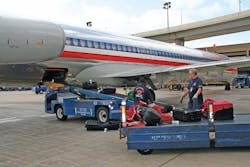SMS Jargon and Collecting Predictive Data
The International Civil Aviation Organization (ICAO) guides the direction of required safety programs. Its safety management manual (Google the term "ICAO SMM") describes the multitude of suggested requirements for a safety management system (SMS). The requirements apply to airlines, charter companies, MROs, airports, air traffic organizations, and others.
Each organization must have a formal means to collect, analyze, and apply results from three different types of data: reactive; proactive; and predictive.
FAA aligns guidance with ICAO; different data requires different methods to collect, analyze, and use the information to promote safety.
SMS Data Types
When looking at reactive data, the event has already occurred and the damage done. Depending on the severity of an event, it can be heard about on the news. However, many other events, such as a runway incursion, high value ramp damage, or worker injury, may remain known only to the airline or company personnel involved.
Companies usually have accident/event procedures in place and are prepared to launch an investigation team and establish fact-based contributing factors. There are very good processes to interview those involved; companies usually have the means to determine the cause and take actions to ensure that the event never happens again.
Afterward, the FAA and any number of industry organizations and publications help disseminate accident/event data. This helps reduce the chance that the event may be repeated by another company.
The event investigation process, the data collected, and the final report is merely a reaction to the event — hence, the term "reactive" data. There is high value in learning from the reactive data from big events.
Collecting, analyzing, and applying proactive data is not new, only the emphasis on the term is new. Aviation organizations have auditing, quality, and safety departments that apply a multitude of operational measures to assess current performance and safety.
The FAA Continuing Analysis and Surveillance System (CASS) exemplifies a robust data system. For CASS, the company is responsible for collecting data and assessing the opportunities for improvement.Traditional audits with the IATA, the Coordinating Agency for Supplier Evaluation (C.A.S.E.), and the National Aviation Authority are nothing new.
Getting Predictive
We are a very safe industry; the positive data from 2011 broke all safety records. The United States has gone nearly three years without an airliner accident fatality and the accident rate is considerably down worldwide.
SMS regulations encourage us to take our data collection to the next level. Predictive data systems are a means to use daily/normal operations to help identify a company’s strengths and weaknesses.
Sometimes there is confusion between the terms used in “system safety” versus the language used in “threat and error management.”
Using the language of system safety, predictive data helps identify the small hazards in advance of assigning a risk level. Using the language of threat and error management, predictive data helps identify the threats so that they can be managed before they become errors.
In any language, it is a matter of identifying and addressing challenges as early as possible. How can you establish systems to gather and apply predictive data?
Most likely, frontline employees see the hazards before management does. Predictive data, therefore, must be worker-centered. Companies must make it easy for employees to speak up. Voluntary reporting systems are likely the best means to achieve this goal.
FAA cooperates with the industry through programs such as the Aviation Safety Action Program (ASAP). It protects workers from FAA action when they report mistakes early. Progressive companies use ASAP as a means to report not only events but also to report the conditions (threats) that may lead to events.
Another new program created by FAA with the Airlines for America (A4A), formerly the Air Transport Association, is the Maintenance and Ramp Line Operations Safety Assessment system (MRLOSA). MRLOSA is a formal means for workers to conduct peer-to-peer assessments during normal operations.
Such data may be the very best means to gather and use predictive data.
Understanding LOSA
Line Operations Safety Assessments (LOSA) require employee involvement to identify safety threats to areas of ramp operations. For most airline and airline-related service organizations, an SMS can be a formalization of the many safety programs already in place.
LOSA is a way for employees to observe one another’s work. Although it is peer-to-peer observation, it is a formal process.
LOSA is not new. Since the late 1990s, LOSA has evolved in flight operations and is widely used today. Line pilots, for example, trained to be LOSA observers, fly jump seat and observe the crew. The observer looks for excellent performance, but also observes whether threats and errors are present. The observer is trained not to interfere with normal operations unless there is grave danger to people or property.
Those being observed know that the LOSA is not a classic “audit” and that LOSA data cannot attribute actions to an individual or crew. LOSA is a formal employee system that does real-time risk assessment using the threat and error management model.
The LOSA system for ramp is very different from that used on the flight deck. The philosophy and principles are the same, but the flight deck relies on open-ended text to record the observations.
The ramp LOSA, on the other hand, uses structured observation checklists. The system for ramp comes complete with ready-to-use database and data analysis tools that are kept with the operator. There is no need for outside data storage and analysis. This ensures that company data are secure and that analysis does not require external consultants.
Figure 1 shows the characteristics of the LOSA systems used for maintenance and for ramp environments. It is a systematic means for observation of normal operations. The peer-trusted observers, as well as those observed, participate in LOSA as volunteers.
LOSA is a joint effort by company management and labor to recognize early indications of threats and errors. Sometimes LOSA can be targeted to assess known challenges. In any case, the standards for confidentially always apply.
Implementation Requires Support
LOSA implementation requires strong support from corporate leadership and from the workforce. It requires resources for personnel, training, data analyses, etc. The return on these investments includes an enhanced SMS program, new knowledge of daily risk, and an increase in efficiency and continuing safety. A return on investment tool is under development for use with the LOSA systems.
The development team of government and industry has developed and tested all necessary materials to support the implementation of LOSA for ramp. That includes training documents and manuals, data collection and analyses forms and software, and materials to promote LOSA to the workforce.
Figure 2 shows one example of the many posters available from the www.mrlosa.com website. This site also offers ways to obtain implementation support from participating industry and government partners.
About the Author

Dr. Bill Johnson
Chief Scientific and Technical Advisor Human Factors in Aviation Maintenance, FAA
““Dr. Bill” Johnson is a familiar name and face to many industry and government aviation audiences. Johnson has been an aviator for over 50 years. He is a pilot, mechanic, scientist/engineer, college professor, and senior executive during his career. That includes 16+ years as the FAA Chief Scientific and Technical Advisor for Human Factors.
Dr. Bill has delivered more than 400 Human Factors speeches and classes in over 50 countries. He has 500 + publications, videos, and other media that serve as the basis for human factors training throughout the world.
Recent significant awards include: The FAA “Charles E. Taylor Master Mechanic” (2020); The Flight Safety Foundation - Airbus “Human Factors in Aviation Safety Award” (2018), and the International Federation of Airworthiness “Sir Francis Whittle Award” (2017).
Starting in 2021 Johnson formed Drbillj.com LLC. In this new venture he continues to bring decades of human factors experience to aviators, worldwide.
